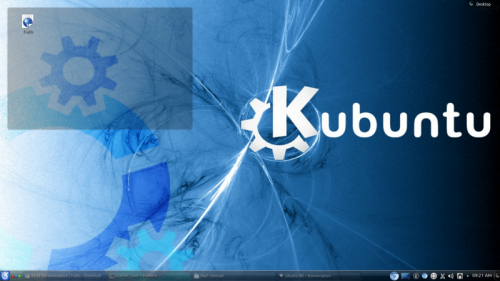Kubuntu/Ús bàsic
Ús bàsic
Aquesta secció de la documentació cobreix els components disponibles a Kubuntu per complir amb la vostra funcionalitat desitjada i crear la vostra pròpia Kubuntu.
Xarxes
Aquesta secció us ajudarà a connectar-vos a Internet.
Per cable
En la majoria dels casos, la connexió de xarxa cablejada simplement funciona sense cap canvi en la configuració per omissió de Kubuntu. Les connexions de xarxa per cable es seleccionen per omissió quan estan disponibles.
Sense fils
La majoria de les targetes sense fils estan implementades pel seu ús amb Kubuntu. No obstant, en alguns casos, el dispositiu de xarxa sense fils pot necessitar un controlador restringit per tal d'operar. La millor manera de comprovar-ho, és obrir l'aplicació jockey-kde (també coneguda com a «Controladors addicionals»). Per obrir aquest programa, feu clic al llançador Kickoff i cerqueu l'entrada Controladors addicionals. Si el dispositiu necessita un controlador restringit, llavors el jockey-kde podrà ajudar-vos amb la selecció, instal·lació i activació del controlador adequat. Una vegada realitzat tot això, haureu de reiniciar el sistema. Per obtenir més informació sobre la solució de problemes amb el Wi-Fi al vostre sistema, consulteu Solució de problemes amb el sense fils.
Llançadors
Kickoff
Com una distribució KDE, la Kubuntu utilitza per omissió el llançador d'aplicacions . El llançador es pot comparar amb el «Menú Inici» de Windows (abans del Windows 8). La icona per llançar el es troba a la part inferior esquerra, molt semblant al Windows XP o 7. Per obtenir més informació sobre com utilitzar-lo i personalitzar-lo, veure Kickoff de Plasma.
KRunner
Like , is a launcher, but it does a lot more than just launching applications. Usually is accessed by pressing Alt + F2. For more information on what it can do, see Plasma Krunner.
Desktop Customization

This section covers the basics of configuring Kubuntu to suit your needs. One of the strengths of the KDE philosophy is the focus on control of just about every aspect of the desktop environment. Wallpapers, themes, widgets, color schemes, splash screens, and more; the options for customization are endless.
KDE-Look is the number one location to find customized settings for the KDE Plasma desktop. Some of the applications even allow direct connections to KDE-Look to download a new configuration or image.
Themes
Kubuntu allows themes to be changed easily. Open and choose in the section, then choose from the list of installed themes. You can change the theme of the Window Decoration, Cursor Theme, Desktop Theme, and the Splash Screen. Pick from the default choices that are installed, or left-click the 'Get New...' button in each section for more choices.
Plasmoids
Plasmoids (also called Widgets) can be added by right-clicking the desktop and selecting , which will bring up a list of Widgets. For more information, see Plasma Widgets.
Panel
By right-clicking on the desktop once again, you can select to get more panels. You can left-click the button on the far right side of the panel to alter the properties of the panel, like changing its height or width or adding Widgets, for example. For more information, see Plasma Panels.
Dolphin
Dolphin is the default file manager in Kubuntu and can be compared with Windows Explorer. Dolphin looks simple because of great design, while having many powerful features. For more information, see Dolphin.
Updating
Kubuntu developers release feature and security updates for applications and packages within the Kubuntu system. When updates become available, Kubuntu will display a message in the System Tray. To update the system, open and click the button. After installing some updates, it may be necessary to restart the computer. If so, Kubuntu will display a pop-up and an icon in the System Tray.
